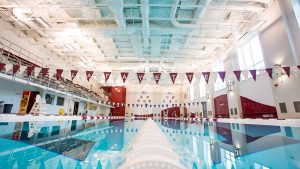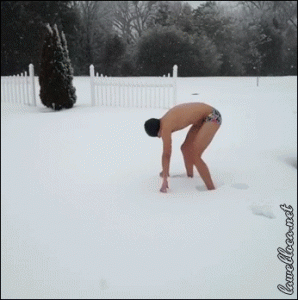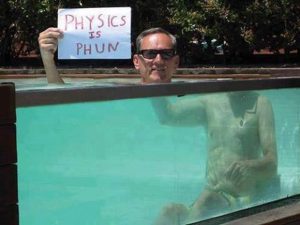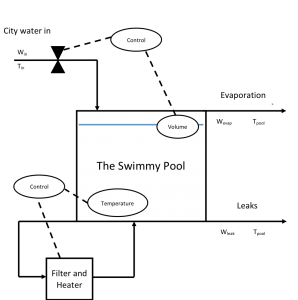Heatin’ Up! (The Lafayette College Pool) by George, Brian, and Erich

What’s The Application?:
Imagine waking up at 5:40 in the morning after a night of studying Process Control, getting no more than six hours of sleep. I know, the first thing you want to do at this moment is get out of bed for a refreshing three or four mile swim. Sounds like heaven, doesn’t it? But alas the pool is chilly, and your morning, as well as the remainder of the day, is ruined. You contemplate your existence. You pee in the pool for the blissful but fleeting moment of warmth your own urine surrounds you with. But just as quickly as it came, it is gone. You are left in the cold yet again.

No more! Using a process control system, we can fix this vexing issue. Firstly, the volume of the pool is currently controlled completely manually. When an employee sees that the water level is low, they turn a valve allowing city water to fill the pool until they feel that the volume is at the right level, after which they close the valve. Additionally, the temperature is controlled by one non-variable heater. This means that when the volume is adjusted, the heat is not, and the pool is frigid until the steady state temperature is reached after a somewhat long time period.
How do we fix this? With SCIENCE!!

The volume (of the) solution (CHEM PUNS)
Our solution involves the use of a feedback control system when it comes to the volume of the pool. The water level of the pool, a function of volume, will be defined as our controlled variable. This is easy enough, simply use a water level sensor. These can be purchased online for very reasonable prices, and they are able to measure the water level when compared to a set point. This setpoint will be the desired water level and will change due to disturbances in evaporation rates or leaks in the pool. The water level sensor will then send a signal to a controller that will interpret the received data. When there is a negative disturbance in the water level, meaning that the water level is too low, this controller will cause a water valve to turn open. This will subsequently allow city water to enter the pool in an amount that will bring the water level back to the set point.
The set point will be fairly easy to determine. The water level should be measured in the diving well portion of the pool, as it receives far less human-related disturbance than the lap swimming portion. The diving well is supposed to be kept at a specific depth of about 13 feet deep. This is 3.96 meters in SI units, but we’re going to stick with feet because FREEDOM. It is then easily determined that the set point should be at 13 feet from the bottom of the diving well.

Also, it is important that the system only responds to negative disturbances. This is due to the fact that when the pool is in use, there will likely be a positive disturbance due to the added volume of bodies. If the system responds to this by draining water, it will constantly have to adjust as swimmers exit and enter the pool. This would be inefficient and extremely wasteful.
It’s getting hot in here, so take off your speedo (maybe not)
The temperature control system for the pool will also be controlled by a feedback control system. The controlled variable will be the temperature of the pool. The water temperature can be disturbed by changes in the air temperature and, more consequentially, the addition of city water from the volume control. Due to thermostats already in the Lafayette College pool, a disturbance in the air temperature will not necessarily have to be accounted for. Therefore, the only variable that can cause significant disturbance is the temperature and volume of city water added to the pool. In order to counteract this, a variable heater will be used to add some amount of heat ,Q, to the circulating water. This Q value will be our manipulated variable. Since there is already a circulation of water taken out of the pool to be filtered, the variable heater will work upon this filtered stream. In this way, there is no need to add another pathway for the heater, it is simply applied to the newly filtered water. The set point for this control system will be 77-82 degrees Fahrenheit (Freedom returns yet again), as dictated by FINA regulations for competition swimming pools.
Did he provide a diagram? He did!

What if I’m A feedforward kind of guy (or girl, science never discriminates)?

If you are looking at that diagram above and saying to yourself, I love this idea but gosh darn it I just hate feedback systems, then too bad, live with it. Just kidding! While feedback systems are great, it is true that sometimes they can have their drawbacks because (in this instance specifically) a temperature cannot be measured until after heat has been put in. Therefore, this could possibly result in a slower pool heat up time if we don’t know exactly how much heat to put in for a specific change in water temperature. Luckily there are two alternative options that can be used if one so pleases, however they keep the use of a feedback system for water level control. Number one, change our temperature control system to a feedforward one. In this instance, we would propose that the temperature of the incoming main city water would first be measured, and then heated to the desired temperature before it is deposited into the pool. Unfortunately this system has a number of potential drawbacks, as it would be unable to account for possible disturbance factors such as a slight air temperature change, and the inability to change the water temperature once the pool has been completely filled. That’s where a dual feedforward and feedback system comes into play. This proposed idea would both heat the main line city water to the desired temperature before depositing it into the pool (feedforward), and also use the feedback system noted earlier. So the entire process would sound like this. A sensor reads the level of the pool. If the sensor gives a reading below the setpoint, a controller will act to open a valve to deposit water into the pool. A temperature sensor will then measure the temperature of this incoming water and if it is below the setpoint, it will be circulated through a heater (inputting Q) until it is at the desired water temperature (77-82 degrees fahrenheit). This water will then be deposited into the pool. Once the pool is no longer being refilled a second temperature sensor will measure the pool water temperature, and if it is below the set point, a certain amount of heat (Q) will be added to the water when it is being passed through the circulating filter. However, while this option ensures the quickest heating times, it potentially uses both more money and more resources than our earlier proposed idea because two heaters are being used instead of one.
Okay then, how will this save the school money (and help the environment)?
 As of right now the city of Easton charges $3.80 d per 100 cubic meters of water (plus a service charge), 5.61¢/kWh for electricity, and approximately $10.12 per thousand cubic feet for natural gas (state of PA). These values may seem small, but added up over a year can become exceedingly high. Every single time that the pool is filled too high precious money is wasted on the excess city water being pumped in. The water level control system easily fixes this problem by adding the actual needed amount of water to the pool. The temperature control system would help save money too. By signaling the heater to heat the pool precisely based on the temperature and known volume of the pool, no money would be wasted on natural gas or electricity for the heating system. These savings could then be used to better benefit the students of Lafayette in ways such as improving housing and academic buildings, or building a completely reasonable 10 million dollar glass elevator. Not only will this system make heating and controlling the pool level more cost efficient, but it will also decrease the pool’s impact on the environment. By using less water, electricity, and natural gas, valuable resources will be conserved and the amount of CO2 emitted by using excess natural gas will potentially decrease.
As of right now the city of Easton charges $3.80 d per 100 cubic meters of water (plus a service charge), 5.61¢/kWh for electricity, and approximately $10.12 per thousand cubic feet for natural gas (state of PA). These values may seem small, but added up over a year can become exceedingly high. Every single time that the pool is filled too high precious money is wasted on the excess city water being pumped in. The water level control system easily fixes this problem by adding the actual needed amount of water to the pool. The temperature control system would help save money too. By signaling the heater to heat the pool precisely based on the temperature and known volume of the pool, no money would be wasted on natural gas or electricity for the heating system. These savings could then be used to better benefit the students of Lafayette in ways such as improving housing and academic buildings, or building a completely reasonable 10 million dollar glass elevator. Not only will this system make heating and controlling the pool level more cost efficient, but it will also decrease the pool’s impact on the environment. By using less water, electricity, and natural gas, valuable resources will be conserved and the amount of CO2 emitted by using excess natural gas will potentially decrease.
So, Can it be implemented in other areas?
Yes! This control system is not applicable to Lafayette’s pool only! The set point for volume will have to be altered for other pools, as not all pools will have a regular level of 13 feet. The temperature control system, however, can be applied to any pool to regulate temperature without any changes required. As such, our system, while specified for the Weinstein Natatorium, can be applied, with only minor changes, to any pool in the world.
References:
- “FR 2 SWIMMING POOLS.” FR 2 SWIMMING POOLS | fina.org – Official FINA website. N.p., n.d. Web. 24 Mar. 2017.
- “AVERAGE PRICE OF NATURAL GAS (per 1,000 Cubic Feet).” Just The Facts – Average Price of Natural Gas – The Public Policy Institute. N.p., n.d. Web. 23 Mar. 2017.
I think the idea of a temperature regulating system for pools is a creative and practical control system, however, I’m not sure how great the demand for the product would be. I think having a pool that is consistently at a set temperature is a desirable attribute that certainly would make entering the pool when it is cold outside a much more pleasant experience. However, given that most pools operate without much issue despite not having this technology now, I’m not sure that owners would be willing to upgrade to this more sophisticated temperature regulating system. Because the quantity of water is so large in a full-size swimming pool, I question how much of an effect the addition of colder city water would have on the overall temperature of the pool. It is unlikely that a temperature change of a few degrees would be cause enough to install a whole new heating system. Only if the pool loses water at a rapid rate that leads to the addition of large amounts of city-water in a small amount of time, could I see a pool necessitating this kind of control system.
The use of two feedback control systems to regulate the volume and temperature of the pool is well done. For the volume, it makes sense to have the control variable be the height of the water and to have city water added based off this sensor. I liked how you accounted for the fact that positive disturbances should not be considered because adjusting to the frequent changes in the number of people in the pool would be impractical. In regard to the temperature control system, I think you covered all the possible disturbance variables and created a control system that could reliably regulate the pool’s temperature. My only concern with the heating system is that it would take a long time for the water to be fully circulated through the heater/filter, so it may be hours after the addition of city water that the temperature is back up where you want it. Because of this time variable, I think your other suggestion of heating up the water before it enters the pool would be more practical and would cause less of a disturbance in the pool.
While I agree with your points regarding the economic and environmental benefits of this process, I don’t believe that they are enough to make this system viable in a real-life application. Yes, sometimes a pool is colder than one would like, but the body normally adjusts quickly, especially if one is actively swimming. I can’t see pool owners finding an economic benefit in installing this new heating system because it will not only cost money to install, but the heating costs would also most likely increase as well since more water is being heated.
Overall this is a very good idea, as a division one swimmer that has to get up before 6am every morning, this is a very useful invention. I absolutely hate getting up at 5:30 and jumping into a cold pool, in fact the only thing I could think of that is worse than jumping into a cold pool is getting up at 5:30 in the morning. In all seriousness, heated pools are nice and warm water is enjoyable no matter what time you jump into it. I can see how annoying it would jumping into a pool that is not full enough and hitting my head on the bottom and dying. That would suck, like a lot. So always having the level of the pool maintained would be nice.
This control scheme makes sense and I like the use of both a feed forward and feedback control system. This will provide more control than just using one or the other. However, if saving energy is a goal and I had to pick between one or the other I would pick the feedback control system. One thing that I do not understand is how the pool will handle the slight disturbances that cause the level to either go up or down. I know that the controller is programmed to know not to fill the pool when the level is too high, but what if the level is at 13ft, then the loch ness monster hops in, displaces a little bit of water out of the pool, the level fluctuates a lot from her impact of entry into the pool. Do you really want the pool to have more water added? I think there should be a certain amount of deviation away from the 13ft level that the pool doesn’t need to be refilled at. This would save energy by recognizing a refill is not necessary and thusly saving energy on pumping.
This is a very usable idea for any person that can afford a heated pool. If having warm water is necessary, then this is a great way to implement it. I think that there could be a way to not always have to use a heater to heat the water. In the summer for instance, would it possible to have an outdoor water heater to heat the water with solar energy, or a way to expose the pool to direct sunlight to heat the water on a sunny day? Overall this is a very good idea to make Lafayette’s most important student athlete’s lives better. I think it would possible to make it more energy efficient as well.
A heated pool sounds much more enjoyable to me, as a person who would rather wear a ski coat on a summer day than have to bear a winter day in Canada with only a T-shirt on. Therefore, I would be very interested in upgrading the pool-heating mechanism to more quickly and accurately regulate the pool temperature. However, there are two main negatives that I see with this change including personal preference and associated heating or technology costs. If it is a widespread feeling among swimmers that the cold pool is a day-ruiner, then this control scheme should be pursued.
The process control scheme makes sense if the level (volume) of the pool is the controlled variable, and the notion that only negative deviation from the setpoint calls for a response is a logical parameter of the design. If more water were added during swim practice when wake is present as a disturbance variable AND bodies in the pool displace water and increase the apparent volume, the possibility of the pool overflowing exists. This leads me to further suggest a PI control scheme, or a PID control scheme with very little “D” impact, because the derivative action could cause unwanted flow changes during periods of “noise” during swim practice.
The temperature control scheme in conjunction with the flow control also makes sense, but I would suggest trying to combine the two into one simplified process control scheme if possible. It is a fair assertion that the air temperature disturbance variable would be less concerning than the temperature changes associated with the addition of city water. The air temperature would most likely have its own control scheme already in place, and would not experience gross fluctuations. The incoming city water poses the biggest potential disturbance, and the proposed feedback/feedforward mechanism would help to negate the effects of entering cold water before the temperature of the pool drops down to an uncomfortable level. I think heating the water before it enters the pool would not be a viable solution because this would lead to two separate heating locations as outlined in your proposal – increasing complexity and cost of the control scheme.
Instead, I think the feedforward control aspect could still be utilized, but just as a temperature and flow measurement to calculate the amount of heat, Q, required to heat the incoming volume of water to the setpoint temperature. With just the feedback loop in place, the temperature of the pool would have to reach equilibrium before the heater could accurately respond to the temperature deviation, increasing the time response of the process. Additionally, I think an aspect of this process that has not been looking into (and has a major impact on your initial reason to create this proposal – discomfort in a cold swimming pool) is the timing of the temperature and volume correction. The pool already has a process in place to maintain a desired temperature setpoint, albeit not as fast, accurate, “robust” as is it could be with the implementation of the proposed control scheme. If the swimming pool currently takes, for example, 5 hours to reach the desired temperature after a volume correction, then these volume corrections should be enacted well before 5:40 am when the swimmers enter the water. If the current manual control process cannot achieve the desired temperature in time for usage (longer than 12 hours to reach temperature setpoint, let’s say) then I think it makes sense to update and improve the control scheme with the feedback/feedforward mechanism.
Also, I dig the enthusiasm and flow of the content. I think a lot of people would be interested in this.
Heatin up peer review
Heatin up is an application that would use control schemes in order to control water level as well as the heat of the Lafayette pool. This application makes sense and I could definitely envision myself implementing something of the sort if I ever owned a pool. I can especially see commercial companies or pool owners who operate their pools year round as being interested in a product like this.
The group talked about a feedback control system, feedforward, as well as a dual feedforward and feedback system. In the case of their project it does make sense to use a dual feedforward and feedback system if they wanted to gain max efficiency out of this process. However, if the readings do not have to be that rapid or a dual feedforward feedback system was too expensive a feedback loop would be a safe option that could be used in its place. The feedforward does have the potential to be slightly more risky but if money and speed are both concerns than this system could be put in place as well. Overall, any of these three control systems could work and be effective in saving money for owners of this system in the process.
The groups idea to control both the temperature and volume of the pool does make sense. To do this they propose changing the input flow rate as well at the heat of the water in and coming out of the pool. It should definitely be possible to control both of these variables, but heat fluctuations also is dependent on the volume and many other factors such as air so more fluctuation in it may occur and therefore would be harder to control. The groups disturbance variables make sense because there is a chance of losing energy into the air. It is also possible that there could be a crack in the pool that would make the pool lose volume faster. However, with a feedback loop in place these disturbances will gradually be detected and fixed over a period of time.
This application could be useful mainly for economic reasons. This is because the control scheme in heatin up makes the accuracy of setting the temperature and volume of the pool much greater. This increase in accuracy would allow the college to save money on water usage and heating costs. This is because by implementing these control aspects the heating and water amounts will be more precise, and overuse will be a lot less than before the implementation. Therefore, after these considerations I could see myself implementing this if I ever owned a pool with the one downside being that my own pool could potentially be too small of scale to save enough energy for it to be worth implementing. However, I do think that this usage could be more useful for larger public pools rather than for personal usage. This is because large public pools generally operate for longer periods of time, and the larger volume and increased energy requirement to heat the pools has potential for greater savings if this control scheme was implemented.
This sounds like a great idea! Cold pools aren’t only a problem at Lafayette, but almost in all places with a cold climate. People who like swimming should be able to go swimming during winters too, which will hopefully be achieved using this application. It makes sense that the water level sensor would only act to negative disturbances, as in when the water level is lower than the setpoint, because you want the pool to be of a certain volume at all times, but you don’t want it to overflow which is why it doesn’t respond to positive disturbances. It was a little hard for me to envision the effect of the water coming in from city water on the overall temperature of the pool, when we don’t know the temperature of the city water. I’m assuming it correlates to the weather temperature on a given day. Therefore, early in the mornings or in cold weathers, adjusting the volume to reach a setpoint will cause a decrease in the overall temperature of the pool. Since you’re trying to control both volume and temperature in relation to each other, I’d suggest the use of a PI controller, since it produces an output value proportional to the magnitude and the duration of error. I like how you proposed two control mechanisms: feedback and feed forward. However, the feed forward one isn’t cost efficient and it requires more resources than the feedback since you’re using two heaters instead of one. The proposed control scheme for the feedback system seems easier to implement, since you’re measuring the temperature of city water and according to the temperature, you add in Q, to ensure that the temperature of the pool is 77-82 degrees Fahrenheit. However, a dual feedback and feed forward system seems more accurate since it controls both the volume and temperature simultaneously, by manipulating one variable, the Q. One thing that you could look more into is time; the duration the heater needs to reach the desired temperature, the time the water level sensor takes to respond and how long it takes to fill the pool to the set volume, and for the heater to heat up the pool. In the case of a PI controller, to achieve an accurate response, the duration of the error should be accounted for.
I like how the economic part was covered by mentioning the values that Easton charges for certain amounts of water and electricity, and the environmental implications were considered, as well. The proposed control scheme seems accurate, robust and very safe to implement as long as the heater doesn’t go crazy and increase the temperature drastically. Also, when a pool is crowded with people, these people are most probably urinating and sweating in the pool, how much might this affect the temperature?
Lastly, I like the style of writing and the passion you guys showed for the application! Good Job.
I think the application of automatically regulating the water level and temperature in a pool is a great idea. I think many pools could benefit from this type of system for both swimmer comfort and economic/sustainability reasons. The article claims the product can be applied to any pool, but I think the article largely addresses indoor pools only. I realize that indoor pools are used more frequently and the conditions are more predictable, but from a consumer standpoint I think either the intended scope should be more clearly stated to only include indoor pools, or some considerations should be made for monitoring the water level (and potentially temperature) for city-fed outdoor pools as well. Additionally, I think as a potential user the article could be clearer as to what is being sold. The equipment and setup is described and certainly seems feasible, but I thought it was unclear what exactly is being sold and what is expected that the customer already has in place. Finally, I appreciated the consideration of measuring from the diving well, but I wonder if the application could be used for pools that may not have a diving well.
The control scheme also seems reasonable. Controlling water level through automatic manipulation of the water supply seems a fairly straightforward feedback loop, and I liked the consideration for the placement of the sensor. However, I think more could be said about the placement of the sensor compared to the water inlet (meaning should they be spread out or can we assume the water level is constant compared to a reference?). For the temperature control, I like both the pure feedback loop and the combined loop system, I just think it is slightly confusing the way they are presented. I would prefer they were in the same section and presented as a choice, or the pros and cons for each could be more clearly stated. Additionally, if the system is able to be implemented for outdoor pools or pools surrounded by a lot of windows I think air temperature is a variable that should be addressed.
I think the application definitely has potential for actual use. I like that numbers were provided for costs of resources that are already used, I think it provided good context for the fact that maintaining a pool can be expensive. To that end, I wonder if continuous monitoring of factors such as water level and temperature and could end up being just as costly as the manual valve control and existing heater. I like the idea of adding the heating unit to the filtration system, but if the heater were to break or need maintenance that may require shutting down the pool to fix. I suggest you pick potentially pick a site that is easier to maintain or argue further why this is the best location, such as that it aids in mixing, etc. Overall, good idea, good tone to the article (although technical in some places), and thoughtful insights to cost and environmental benefits.